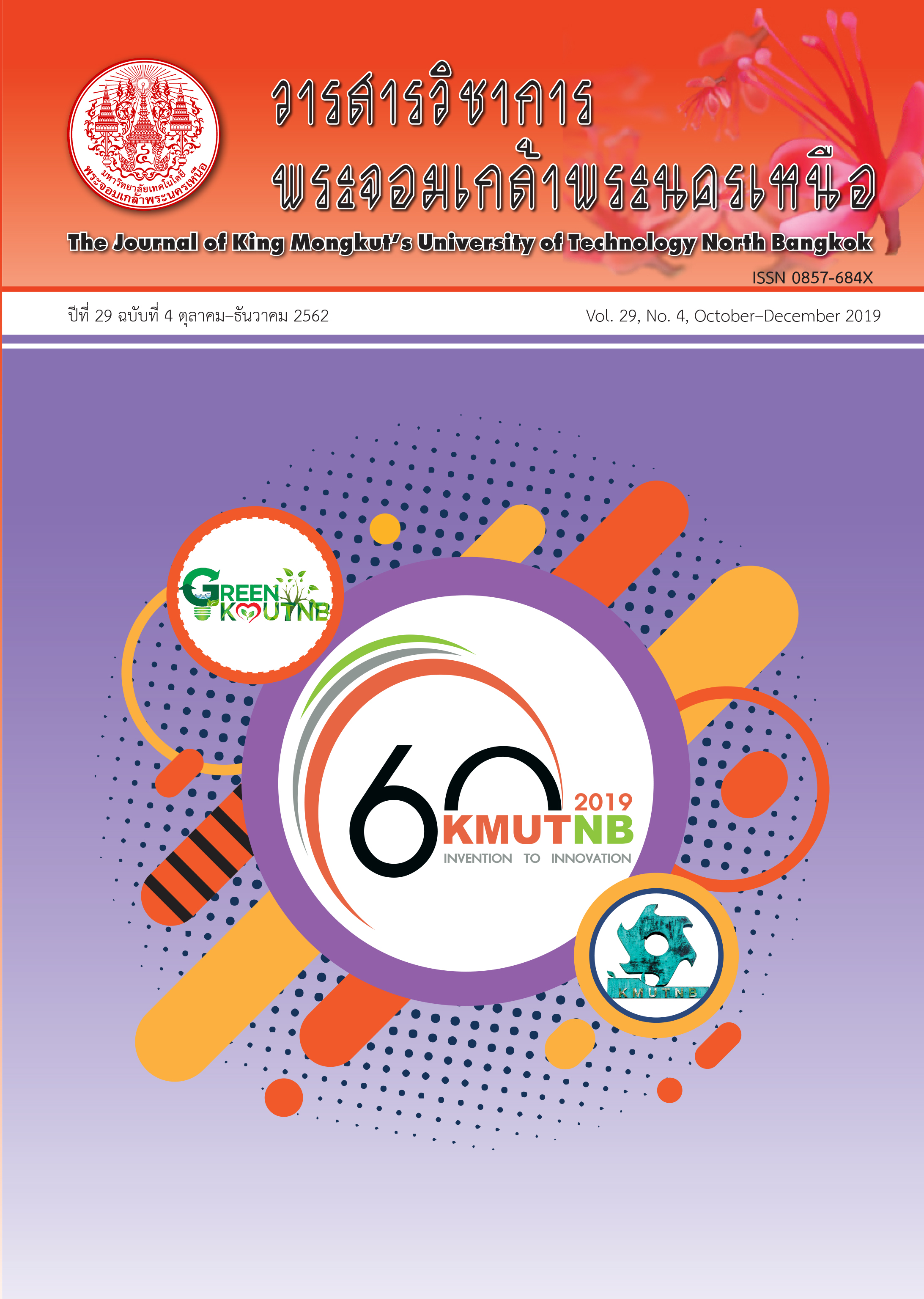Power Consumption Management of Sample Enterprises in Rice Mill Factories, Hotels and Ice Factories
Main Article Content
Abstract
บทความนี้เป็นการศึกษาศักยภาพในการลดค่าไฟฟ้าด้วยการจัดการใช้ไฟฟ้าเพื่อลดค่าไฟฟ้าของกิจการขนาดกลาง โดยการนำข้อมูลโครงสร้างอัตราค่าไฟฟ้าของการไฟฟ้าส่วนภูมิภาคปี พ.ศ. 2558 สำหรับผู้ใช้ไฟฟ้าที่รับแรงดันไฟฟ้า 22–33 กิโลโวลต์ มาวิเคราะห์ นอกจากนี้ยังได้นำข้อมูลค่าไฟฟ้าของกลุ่มกิจการขนาดกลางในเขตภาคเหนือจำนวน 36 แห่ง ประกอบด้วยโรงแรม 12 แห่ง โรงน้ำแข็ง 12 แห่ง และโรงสีข้าว 12 แห่ง มาศึกษาศักยภาพในการลดค่าไฟฟ้าตามแนวทางการจัดการใช้ไฟฟ้าอีกด้วย ซึ่งจากผลการศึกษาโครงสร้างอัตราค่าไฟฟ้า พบว่าผู้ใช้ไฟฟ้าที่มีค่าสัดส่วนการใช้พลังงานไฟฟ้า (kWhP/kWhTotal) ต่ำกว่า 0.4 หรือมีค่าตัวประกอบการใช้ไฟฟ้าต่ำกว่า 0.09 จะมีค่าไฟฟ้าเมื่อคิดจากอัตรา TOU ถูกกว่าอัตราปกติเสมอ และผู้ใช้ไฟฟ้าประเภทอัตรา TOU สามารถลดค่าไฟฟ้าฐานต่อหน่วยได้สูงสุดประมาณ 25 สตางค์ เมื่อสามารถลดสัดส่วนการใช้พลังงานไฟฟ้าลงได้ 20% ส่วนค่าตัวประกอบการใช้ไฟฟ้าที่เหมาะสมสำหรับการควบคุมค่าใช้จ่ายในส่วนของค่าพลังไฟฟ้าจะแปรผันกับค่าสัดส่วนพลังไฟฟ้า (PPeak/P) และค่าตัวประกอบการใช้ไฟฟ้าของ PPeak ที่เหมาะสมนั้นไม่ควรจะต่ำกว่า 0.6 จากผลการศึกษาข้อมูลการใช้ไฟฟ้าของกลุ่มตัวอย่างทั้ง 36 แห่ง พบว่ากิจการที่ใช้ไฟฟ้าอัตราปกติเดิม จะมีศักยภาพสูงในการลดค่าไฟฟ้าด้วยการเปลี่ยนประเภทผู้ใช้เป็นอัตรา TOU และกลุ่มกิจการตัวอย่างที่นำมาศึกษาทั้งสามกลุ่ม มีศักยภาพในการลดค่าไฟฟ้าด้วยการเพิ่มค่าตัวประกอบการใช้ไฟฟ้า
Article Details
The articles published are the opinion of the author only. The author is responsible for any legal consequences. That may arise from that article.
References
[2] J. Nuritanont, “Consideration of suitable rate selection of electricity charge for medium industries,” Engineering Transactions, vol. 1, no. 2, pp. 181–185, 1998 (in Thai).
[3] A. Kunchornrat, “Suitability in using TOD and TOU rate for commercial buildings,” M.S. thesis, Department of Energy Management Technology, Faculty of Engineering, King Mongkut’s University of Technology Thonburi, 1999 (in Thai).
[4] P. Loganthuri and S. A. Subbulakshmi, “New proposal to implement energy management technique in industries,” in Proceedings International conference on Computing, Electronics and Electrical Technologies (ICCEET), Sivagangai, India, 2012, pp. 495–500.
[5] Tennessee Valley Public Power Association Research & Development. (1994). Distribution System Loss Reduction Manual. [Online]. Available: https://www.alexanderpublications.com/products/733b
[6] Power Planet-Electrical Management Systems. (2018, July). Power Planet. Power Planet - Electrical Management Systems. Fullerton, California [Online]. Available: http://www.demandcharge.com/Web_Pages/Articles/Electrical_Load_Factor.html.
[7] S. Kulwatnanchai, “Training documents; Total energy management activities to raise the level of energy efficiency for industry (Training Class 8th),” Department of Industry Promotion. 2008.
[8] Tennessee Valley Public Power Association Research & Development. (1994). Distribution System Loss Reduction Manual. [Online]. Available: https://www.alexanderpublications.com/products/733b
[9] R. Diewvilai, R. Nidhiritdhikrai, and B. Eua-arporn, “Impacts of demand side management on reserve margin for generation system planning,” Journal of Energy Research, vol. 9, no. 1, pp. 17–29, 2012 (in Thai).
[10] Policy and Statistical Technique Division. (2012). Sampling and Estimation Technique. National Statistical Office.Bangkok, Thailand [Online]. Available: service.nso.go.th/nso/nsopublish/Toneminute/files/55/A3-16.pdf

